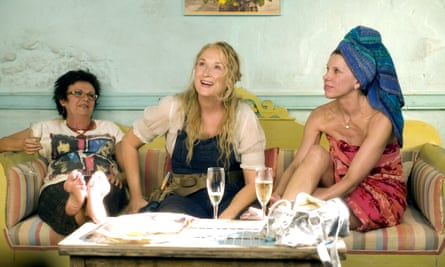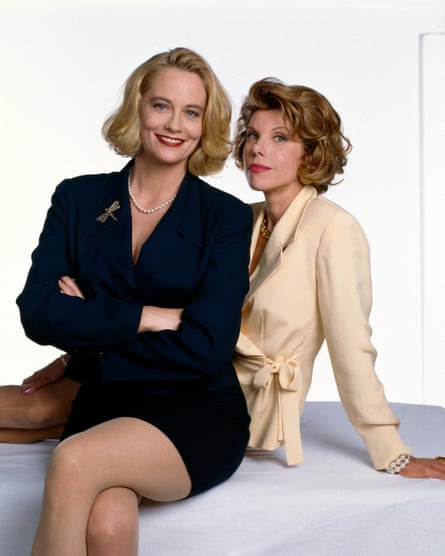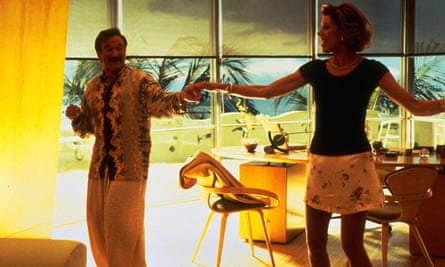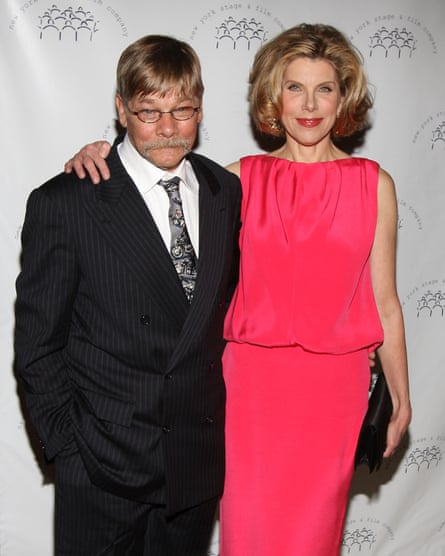Christine Baranski is an “Oh, her …” kind of actor. Casual observers might not recognise her name, but they always, instantly, know her face. “Oh, her,” they say, when they see her starring in The Good Fight, the successful spin-off to the TV drama The Good Wife, in which she also co-starred. “It’s the woman who played Leonard’s mother on The Big Bang Theory and Meryl Streep’s high-kicking friend in Mamma Mia!” “Oh, her,” they say, when they spot her in comedy classic Bowfinger. “It’s the woman who brings sass and class to whatever she’s in.” Exactly. That’s her.
With her high-toned enunciation and elegant bearing that verges on regal, Baranski seems like the human embodiment of Manhattan’s Upper East Side circa 1955, and when we connect via video call she initially fulfils all preconceptions. “Now, tell me about London, how are things going there? Oh, I’m so sorry,” she says.
Her emphases and enunciations – “what” is “w-hat”, “gorgeous” is “gor-ge-ous” – make her a little reminiscent of theatrical characters from bygone eras, such as those in the musical Mame and the women in Follies. Baranski has appeared in both of those shows because, alongside her TV and movie career, she is a theatrical force, as at home in Broadway musicals as she is in TV dramas, and she has two Tony awards alongside her Emmy and SAG awards to prove it.
Today, she is sitting in her elegant apartment on, yes, Manhattan’s Upper East Side, decorated with expensive looking wall-hangings and chic patterned curtains. The 69-year-old is looking pretty expensive and chic herself, with a trim dancer’s figure that suggests she’s not really one for big lunches.

But she’s far warmer than her glossy exterior suggests, cooing delightedly when I apologise for the noise of my children (“Oh, your babies!”) and fretting that she won’t give me good enough copy. In fact, she is a far cry from the well-born lady she looks like – and invariably plays.
“Even when I was studying acting at the Juilliard, I was often cast as the sophisticated best friend with the witty line, and it’s so funny to me because I do not come from a wealthy background. I’m from a blue-collar neighbourhood in Buffalo, New York, and if you’re writing for the Guardian, you could say that’s like Manchester,” she adds helpfully (although I reckon Newcastle is a closer English equivalent to Buffalo).
Baranski grew up “a latchkey kid”, the daughter of a working mother who struggled to pay the bills after Baranski’s beloved father died when she was only eight. Her grandparents were Polish immigrants and she grew up in a Polish-American community. I tell her that I, too, am third-generation Polish and no one in my family sounds like her.
“You know, I remember even in high school people would say: ‘You don’t sound like us, you sound English.’ I think I decided early on that I wanted to speak a certain way, and it was a projection on my part. I wanted to go to New York and be a theatre actress, and I’m living my image of the kind of woman I wanted to be,” she says.
Was she rebelling against her background? “It wasn’t a rebellion, but by junior high [12 to 13 years old] it was clear to me I wasn’t going to stay in Buffalo. I was on fire once I realised how empowered I felt on the stage.”
When she was a teenager, Baranski’s idol was Maggie Smith. Now, pleasingly, Baranski is playing what can be described as “the Maggie Smith role” in Julian Fellowes’ new HBO series, The Gilded Age, which can equally be called “American Downton”. It is set in New York, and in the 1880s as opposed to the war years. But otherwise, it’s got all of Fellowes’ hallmarks: bossy mistresses of the house, grumbling servants and fascinatingly bizarre snobberies.

Here, the biggest snob is Baranski’s character, Agnes van Rijn. She refuses to let her young niece (Louisa Jacobson), who has just arrived in New York, mix with any of the “new people”, ie those whose ancestors arrived more recently than 200 years ago. Baranski fits the role like a lady’s hand in a satin glove. “Does anyone write a snob better than Julian Fellowes? That class of people who don’t even know what a weekend is,” she says, with relish.
Fellowes had Baranski in mind when he created the part because years earlier, when they’d met at an industry event, she had told him she was a fan of Downton. She also mentioned that her husband’s grandmother was the author and heiress Elizabeth Drexel Lehr, “and Julian knew the Drexels well”, which is more than I do (quick research reveals they were an old American banking family).
Baranski had never been in a period film or TV show, but has done plenty of restoration comedies and Shakespeare on stage, “so I know my way around a corset and wig”. When Fellowes finally finished writing The Gilded Age and came knocking, Baranski had only three words for him: “Yes, yes, yes.”
As well as The Gilded Age, Baranski is the star of The Good Fight, which will soon release its sixth season. Between The Good Wife and The Good Fight, she has played the wildly adored liberal lawyer Diane Lockhart for 13 years. The danger of doing anything for so long, she says, “is you run out of colour, but we react to current events. We could be on until the ice caps melt.”
As careers go, it’s not bad for a woman on the verge of 70, who didn’t even start acting on TV until her early 40s. “I can look back and think: ‘How often did I not get a role because I wasn’t pretty enough?’ But look at the position I’m in now – two great roles, [my characters are] both No 1 on the call sheet. I’m like: ‘Damn! Late 60s and here I am.’ There is progress!” she laughs.

There is progress, but there is also Baranski, who has always felt more like an exception than a rule. After graduating from the Juilliard, she won her first Tony in her second Broadway play, when she played Charlotte in Tom Stoppard’s The Real Thing, in which Cynthia Nixon – who now plays her sister in The Gilded Age – played her daughter. Stephen Sondheim spotted her soon after, and she not only worked on most of his musicals, from Company to Assassins, but she also became his friend.
“I was playing Mrs Lovett in Sweeney Todd in Washington, and Steve came to see our first run-through, which happened to be on my 50th birthday. Afterwards, I went out to a fish restaurant with my cast. Then, suddenly, Steve turned up! He said: ‘I never miss a 50th, and he drank glass after glass of wine, talking about what it was like to be part of West Side Story. I thought: ‘Who gets a birthday like this?’” she says.
Although Baranski has an apartment in New York for work, her main home is in Connecticut, and it sounds as if she lives in a particularly exciting corner of the state, given that her neighbours include Meryl Streep, Patti LuPone and – until his death in November – Sondheim. “After Meryl and I did Into the Woods,” she says, referring to the 2014 film adaptation of Sondheim’s musical, in which she played Cinderella’s wicked stepmother and Streep starred as the witch, “I’d say to her: ‘Let’s get together with Steve!’ So I had the pleasure of some long dinners with him.”

Baranski met her husband, Matthew Cowles, who was also an actor, when they appeared in Ibsen’s Ghosts in 1982. He offered her a lift home on his motorcycle “and the rest is history”, she says. They moved to Connecticut because he inherited his family home there, but raising their two daughters on theatre actors’ wages wasn’t easy. So, when Baranski was offered a role on Cybill in the mid 90s, the money was tempting, but the prospect of commuting to LA every week was not. The money won. “It was a very anguished decision. My girls were five and eight, I think, and Matthew stayed home with them. But when I read the script by Chuck Lorre, this guy I’d never heard of, and saw how he’d written the character Maryanne, with the dry wit and martinis, I thought: ‘Oh, I know how to play this.’”
She did. The show was supposed to be a star vehicle for Cybill Shepherd, but Baranski instantly stole it, and at the end of the first season she won an Emmy. Shepherd did not. Lorre has since claimed that Shepherd was jealous of Baranski. Shepherd put it differently in her memoir, Cybill Disobedience, insisting that the reason she and Baranski didn’t get on was because Baranski was unfriendly. Alicia Witt, who played Shepherd’s daughter, later said that Shepherd “kinda said some pretty mean things about pretty much everyone she worked with, as I understand”. The show ended after four seasons.
“I have never publicly gone into that,” says Baranski when I ask about Shepherd. “Yes, there were issues, but I prefer to take the higher ground and say, look, that show gave me so much. I was fine working with her. Politically, it did get difficult, but I wish her well.” And clearly she got on with Lorre better than Shepherd did, given that he later put her in his world-dominating sitcom, The Big Bang Theory.
Even before Cybill ended, Baranski was getting offers of roles in films. One of the first she accepted was in the American remake of the French comedy classic, La Cage aux Folles, which was re-titled The Birdcage and directed by Mike Nichols, playing Robin Williams’ sort-of ex. Did she and Williams stay friends afterwards?

“Not friends exactly – he was already a huge star and I lived back east. But he did give me a beautiful book at the end of shooting, about [the theatre actor] Katharine Cornell, who was also from Buffalo. Anyone who knew him would say he had the most extraordinary beauty, a kind of warmth and sweetness …” she trails off fondly.
In The Birdcage, she has an especially memorable scene in which she – in the world’s tiniest miniskirt – and Williams dance, and I tell her it’s astonishing how she looks basically the same in that as she does in her dance scene in Mamma Mia!, despite the two decades between the two films.
“I find it a professional obligation to stay in shape. If we’re talking girl talk, I do pilates, because it keeps me toned and strong. As an actor, you have to protect your instrument, so I wouldn’t smoke now because it affects the voice. You have to be able to do whatever they need you to do, even after 14 hours of work,” she says.
Baranski is, to use that very old-fashioned theatrical term, a trouper. But given that we’re talking girl talk, I say, was it ever hard for her husband that she was so much more successful than him? She considers her words carefully before answering.

“All successful women know this: you pay a price for being the person who gets more wattage. I remember once, on the red carpet, a photographer actually shouted at him: ‘Get out of the way, you’re standing in her light.’ Matthew was so gracious, saying: ‘Of course, of course.’ But I just cringed inside, it was my Judy Garland moment,” she says, referring to the scene in 1954’s A Star is Born, when James Mason is shoved aside by photographers to get a photo of Garland.
“I think every marriage is supremely challenging, but my late husband was enormously supportive and very proud of me, and I think we managed it quite well. He was an exceptional person.” She starts to recall a time when he encouraged her to take a part when she was wavering, but suddenly breaks off, crying. Cowles died in 2014.
We turn to more cheerful subjects, namely, their daughters, Lily, who is an actor, and Isabel, “who has given me three beautiful grandsons. They. Could. Not. Be. Cuter!” she says with emphasis, but the tears are still there. I apologise for bringing up painful memories.
“Oh no, I’m happy to know that the love I have for him is still so real. Too often, we look at our lives and we have regrets, and what makes good copy is people bad-mouthing each other and talking about how hard it was. But I’m not that person. I look at myself and I say: ‘How lucky was I?’”
The Gilded Age will be available from 25 January on Sky Atlantic and streaming service NOW.
